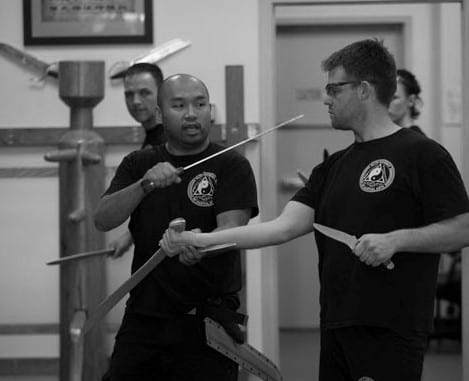Elite Academy Kali / Eskrima / Arnis Classes
Ages 16+
Tuesday & Thursday : 8:30pm Saturday : 1pm
Kali is the Western name for the family of styles known elsewhere as Eskrima and Arnis, umbrella terms for the traditional martial arts of the Philippines. Also known as Filipino Martial Arts or FMA. Traditionally, these martial arts develop one’s skill with sticks (both short and long); knives, swords, and other bladed weapons, including hatchets and tomahawks; various improvised weapons; thrown weapons, such as throwing knives; bow and arrows; and even firearms. It also includes hand-to-hand combat and disarming techniques.
All other things being equal, an armed person with training has the clear advantage over an unarmed person with similar training. Most systems of Kali apply a single set of techniques for the stick, knife, and empty hands, a concept sometimes referred to as “motion grouping.” Since the weapon is seen as an extension of the body, the same angles and footwork are used with or without a weapon. Thus, unlike students in most other martial arts, Kali beginners first learn to fight with weapons, graduating to empty-hand training only once the stick and knife have been sufficiently mastered. This regimen presumes that empty-hand moves are acquired naturally through the same exercises as the arguably more complex weapon techniques; the muscle memory necessarily developed via weapon training thus informs weaponless combat, rather than forcing students to “learn uphill” the other way around once they have mastered hand-to-hand techniques. A key feature of Filipino martial arts is the “live hand,” meaning that even when a practitioner wields only one weapon, the extra hand is used to control, trap or disarm an opponent’s weapon and to aid in blocking, attacking, disarming, and joint locking.
At EAMA students start with stick and knives and progress on to other weapons such as sword, tomahawk, improvised weapons, and firearms. Students are taught environmental, situational, and mass attack tactics to help them respond appropriately to real world attacks. Class is an hour long and consist of individual drills, partner drills, and sparring. Sparring can last up to 25 mins and students may fight one on one, against multiple opponents, and in teams. Environment plays a major role in Kali sparring so students may spar inside the school, in the utility hallways behind the school and even in the parking lot.

